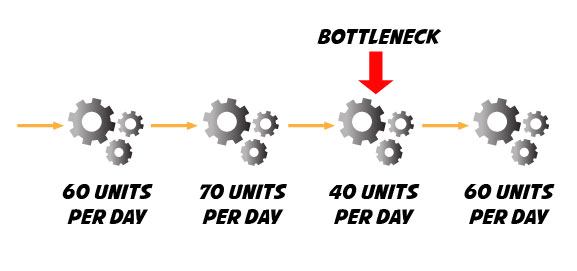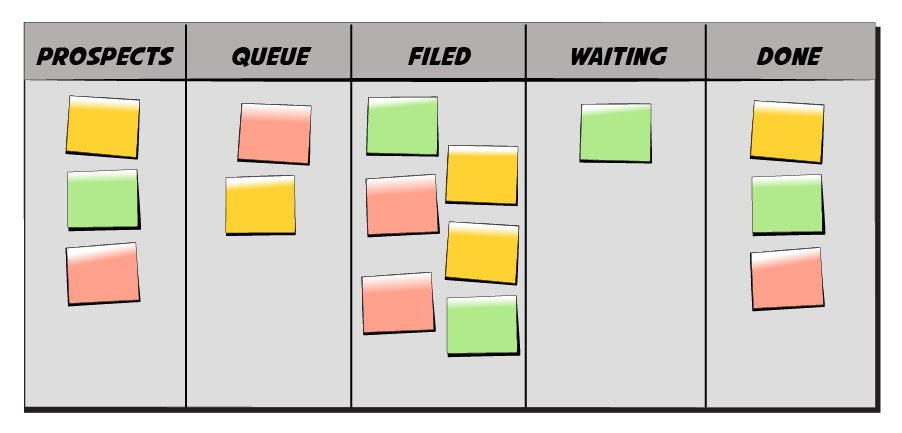Reducing Cycle Time By Removing Bottlenecks

Imagine you’re leading a troop of twelve scouts on a wilderness trip. Your responsibility is to make sure that the children make it from point A to point B on their hike without anything terrible happening to any of them (like getting eaten by a bear!) You quickly discover that it doesn’t matter how fast your speediest kid is because your overall speed is dictated by the slowest scout in the troop.
This story paraphrases one of the critical anecdotes in the book The Goal, a best-selling business book that explores an industrial engineering principle called “theory of constraints.” That principle illustrates the following point: Your overall speed is only as fast as the slowest process in your system.
To draw an analogy from a factory context, imagine if a process had four steps: Step one produces 60 items per day. Step two has the monster performance of 70 items per day. However, at step three, only 40 items a day can be processed, before step four speeds things up at 60 items per day.

The fastest this system can produce is 40 items per day. Step three is the slow kid in the scout troop. Even though there are some super-optimized parts of this organization, they have what’s known as a “bottleneck” or “constraint” that limits the overall output.
Identifying Law Firm Bottlenecks and Removing Them
If you can identify bottlenecks in your own firm, then you can reduce cycle time, which leads to increased throughput rate and income.
One common bottleneck a law firm encounters happens toward the end of a case. The case may be resolved, but it needs to be pushed over the finish line as money still needs to be collected. Frequently, I advise managing partners to examine their work-in-progress cases and see what can be moved to conclusion. Even PI attorneys who win cases are slow to collect. Sometimes they are so consumed with the legal victory that they don’t move the settlement funds along.
Another bottleneck occurs when a law firm markets their firm, but does not follow up with their leads. Year ago, Rocket Matter experimented with an online marketing service which built websites for law firms and drove traffic to them. In one instance, a law firm was complaining that we weren’t helping them get any new business. When we looked into the situation, we discovered that we successfully supplied them with more than 200 leads in a two-week period. However, the leads were halted by a bottleneck—in this case it was their sales process—as they did not have a system to handle them.
Even removing a couple of days from cycle time here or there can have an impact on revenue. My co-author of The Lean Law Firm, Dave Maxfield, described a bottleneck he found in his law firm. In his county, he could either file cases via mail or in-person at the courthouse. It seemed to make sense not to waste a valuable employee’s time on going to the courthouse. It appeared to be a no-brainer to just mail in the filings.
It turns out that was a mistake. By the time the mail was delivered, processed, and sent back to Dave, seven days elapsed. For his profitability, it made a lot more sense to do the counterintuitive move of simply having a paralegal drive to the courthouse and file in person.
Bottlenecks can happen at any phase during a legal process. The more times you hand off work between parties, the greater the chance you have for a delay. Picture in your mind those individuals at your firm with overflowing inboxes. All it takes is one person in your law firm who is slow to produce, and the entire system can slow down.
The best way to identify bottlenecks is through Kanban boards. In the following example, we can see a pileup of cards in the “Filed” column. We see six case units there but only one in the “Waiting” column.

What this tells us is that cases are not moving from one phase to the next. What we need to then do is dive into the cases in the “Filed” column and see what’s going on. Why are they being held up? Who are the players involved? What can be done to remove the logjam?
You’ll find that removing constraints is a little like playing whack-a-mole at a carnival. As soon as you eliminate one, another one will surface.
The good news is that even though the bottlenecks move around, each optimization brings about greater overall efficiencies and reduction in cycle time.
Share post:







